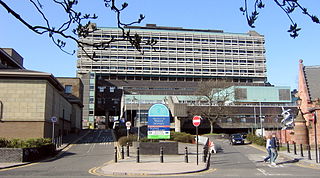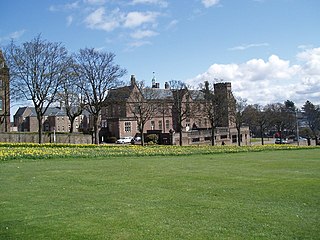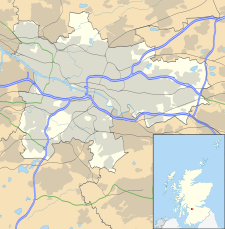
Sir William Macewen, was a Scottish surgeon. He was a pioneer in modern brain surgery, considered the father of neurosurgery and contributed to the development of bone graft surgery, the surgical treatment of hernia and of pneumonectomy.

Saint Mary's Hospital is a hospital in Manchester, England. It is part of Manchester University NHS Foundation Trust. Founded in 1790, St Mary's provides a range of inter-related services specifically for women and children. In 1986, St Mary's Sexual Assault Referral Centre was the first sexual assault referral centre (SARC) to open in the UK.

Whipps Cross University Hospital is a large university hospital in the locality of Whipps Cross in Leytonstone and is within Epping Forest in the London Borough of Waltham Forest, London, England. It is managed by Barts Health NHS Trust.

The Princess Royal Maternity Hospital is a maternity hospital in Glasgow, Scotland. It was founded as the Glasgow Lying-in Hospital and Dispensary in 1834 in Greyfriars Wynd, just off the city's High Street. It moved to St Andrew's Square in 1841, then to Rottenrow in 1860 and to the Glasgow Royal Infirmary site in 2001. It is managed by NHS Greater Glasgow and Clyde.

Matron is the job title of a very senior or the chief nurse in several countries, including the United Kingdom, and other Commonwealth countries and former colonies.

The Bristol Royal Infirmary, also known as the BRI, is a large teaching hospital in the centre of Bristol, England. It has links with the nearby University of Bristol and the Faculty of Health and Social Care at the University of the West of England, also in Bristol.

The Western Infirmary was a teaching hospital situated in the West End of Glasgow, Scotland, that was managed by NHS Greater Glasgow and Clyde. It was opened in 1874 and closed in 2015.

The Royal Infirmary of Edinburgh (RIE), often known as the Edinburgh Royal Infirmary (ERI), was established in 1729 and is the oldest voluntary hospital in Scotland. The new buildings of 1879 were claimed to be the largest voluntary hospital in the United Kingdom, and later on, the Empire. The hospital moved to a new 900 bed site in 2003 in Little France. It is the site of clinical medicine teaching as well as a teaching hospital for the University of Edinburgh Medical School. In 1960, the first successful kidney transplant performed in the UK was at this hospital. In 1964, the world's first coronary care unit was established at the hospital. It is the only site for liver, pancreas and pancreatic islet cell transplantation and one of two sites for kidney transplantation in Scotland. In 2012, the Emergency Department had 113,000 patient attendances, the highest number in Scotland. It is managed by NHS Lothian.


Stobhill Hospital is located in Springburn in the north of Glasgow, Scotland. It serves the population of North Glasgow and part of East Dunbartonshire. It is managed by NHS Greater Glasgow and Clyde.

Gartnavel General Hospital is a teaching hospital in the West End of Glasgow, Scotland. The hospital is located next to the Great Western Road, between Hyndland, Anniesland and Kelvindale. Hyndland railway station is adjacent to the hospital. The name Gartnavel is derived from the Gaelic GartUbhal (apple) – i.e. "a field of apple trees". It is managed by NHS Greater Glasgow and Clyde.

The Royal Alexandra Hospital (RAH) is the main hospital in Paisley serving a large catchment area stretching all the way to Oban and Argyll. The hospital is managed by NHS Greater Glasgow and Clyde.

Inverclyde Royal Hospital is a district general hospital in Greenock which serves a population area of 125,000 consisting of Inverclyde, Largs, Isle of Bute and Cowal Peninsula. Inverclyde Royal Hospital is one of three main hospitals in the South Clyde area, alongside Vale of Leven Hospital in Alexandria and Royal Alexandra Hospital in Paisley and is managed by NHS Greater Glasgow and Clyde.

Dundee Royal Infirmary, often shortened to DRI, was a major teaching hospital in Dundee, Scotland. Until the opening of Ninewells Hospital in 1974, Dundee Royal Infirmary was Dundee's main hospital. It was closed in 1998, after 200 years of operation.

The Queen Elizabeth University Hospital (QEUH) is a 1,677-bed acute hospital located in Govan, in the south-west of Glasgow, Scotland. The hospital is built on the site of the former Southern General Hospital and opened at the end of April 2015. The hospital comprises a 1,109-bed adult hospital, a 256-bed children's hospital and two major Emergency Departments; one for adults and one for children. There is also an Immediate Assessment Unit for local GPs and out-of-hours services, to send patients directly, without having to be processed through the Emergency Department.
The Princess Margaret Rose Orthopaedic Hospital was a hospital in Fairmilehead, Edinburgh, opened in 1932 and closed in 2000. After closure, with services transferred to the new Royal Infirmary of Edinburgh, it was demolished and the site sold for housing.
Ida Barbara Helen Quaile OBE was a Scottish nurse, midwife, Matron of Glasgow Victoria Infirmary and Lady Superintendent of Royal Infirmary of Edinburgh.

Thomas Kennedy Dalziel, known as T Kennedy Dalziel, was a Scottish surgeon and pathologist who specialised particularly in abdominal surgery. Dalziel was most notable for being considered the best technical surgeon at the time in western Scotland. He was also particularly notable for the discovery of a disease called chronic interstitial enteritis in 1913, that later became known as Crohn's disease.
Margaret Gibson Auld FRCN was a Scottish nurse, Matron at Simpson Memorial Maternity Pavilion, Edinburgh and Chief Nursing Officer for Scotland from 1977 to 1988.





















